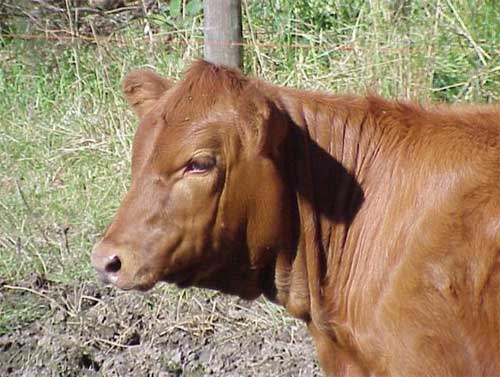Research: breeding heifers can eat less thus reducing costs

A two year study has concluded that heifers being prepared for breeding can safely eat 20% less during the seven months between weaning and breeding, saving producers US$21 (€15.56) per animal
The study:
Researchers at the Fort Keogh Livestock and Range Research Laboratory at Miles City carried out the study using 32 heifers born to mothers that were fed harvested feed from the middle to end of their pregnancies. Each heifer was half Red Angus, a quarter Charolais and a quarter Tarentais. All the animals belonged to the Fort Keogh beef herd.
The heifers were divided into two groups and fed in confinement during the development period between weaning and breeding. Young cows, commonly called heifers, are weaned at seven months and bred for the first time when they’re 14 to 16 months old. Animals in one group for the study ate all they wanted. Their feed bunks were never empty. Animals in the other group ate 80% as much feed as heifers of a common weight.
Researchers came to their findings, in part, by administering two tests that measure how efficiently a heifer turns feed into energy. One test was a glucose tolerance test, and the other was an acetate irreversible loss test. Acetate — a secondary energy source for cows — is produced by fermentation in the rumen. One goal of the study was to see how fast the acetate disappeared from the blood stream and was used for energy.
The scientists administered the two tests at the end of the 140-day development period and again when the heifers were pregnant with their second calves. During the second test, the heifers were no longer in confinement, but they were grazing dormant forage on rangeland. A previous Fort Keogh study found that animals use nutrients differently depending on the time of year. The worst time being in the autumn and winter, when range forage is dormant. Nutrients at that time can’t enter the heifers’ cells as efficiently as at other times.
Conclusion:
The researchers found that heifers with unlimited feed grew faster than the calves on reduced rations, but the heifers that ate less used their feed more efficiently.
"With the cost of fuel and the cost of production increasing, more and more people are open to more ideas. This is one tool producers can put in their toolbox," said Richard Waterman, research animal scientist who headed the study.
Producers have traditionally thought that heifers needed to reach 65% of their full body size by the time they were bred for the first time, but the study disputes that. It shaved the percentage to about 55%, meaning that heifers could be lighter at breeding.
Members of the Fort Keogh team that conducted the heifer nutrition study, in addition to Waterman, were Andrew Roberts, Thomas Geary, Elaine Grings (now at the International Livestock Research Institute in Nigeria), Leeson Alexander and Michael MacNeil.
Fort Keogh is a USDA-Agriculture Research Service rangeland beef cattle research facility. It is run in cooperation with the Montana Agricultural Experiment Station, an agriculture research component of MSU.
Join 26,000+ subscribers
Subscribe to our newsletter to stay updated about all the need-to-know content in the feed sector, three times a week. Beheer
Beheer









 WP Admin
WP Admin  Bewerk bericht
Bewerk bericht